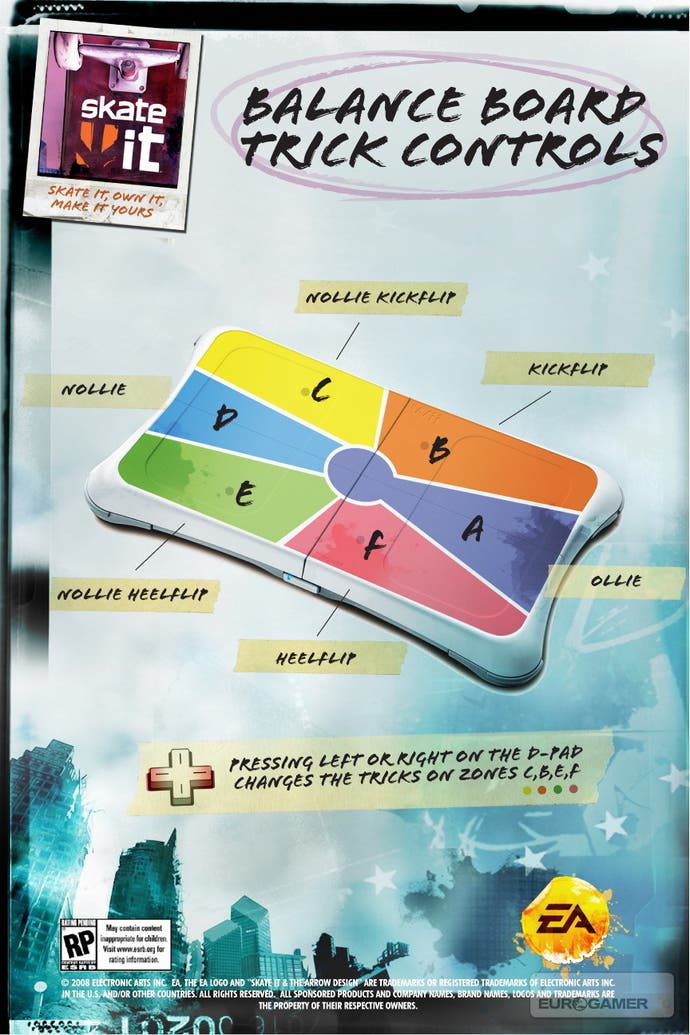Skate It
Skate expectations.
This is both a blessing and a curse, of course, as gradual mastery of a vast repertoire of moves is crucial to the long-term appeal of most skating games. There will be many who fear that Skate It has simply broken that central premise and crossed the line where accessibility turns into a lack of challenge. That would be unfair, though, because, although the tricks are easier to do, co-ordination is required to chain them together, and a big part of the game is still the puzzley element - plotting the best route over the environment to link together grinds and grabs. Skate It's designers have lost none of their skills in this department as they transition between platforms: even the small underpass section available for previewing was filled with numerous ways to optimise your journey and get the most out of the landscape.
As for the option to use the Wii balance board, it's currently at a base level of integration, with just movement implemented, meaning tricks are still orchestrated via the remote. The board was extremely responsive to shifts in weight and direction, but unless EA finds a way to graft a deeper level of controls onto it - something it admits it's currently not sure it can do - then it will be a welcome gimmick at best.
The DS version of Skate It is a little less appealing. Although everything still works - the top screen shows the skater and environment, the bottom is the board - the game feels a little too cramped on a handheld, and the airy fun of the console versions is noticeably lacking. The controls aren't a disaster by any means - tap to push, steer (a little awkwardly) with d-pad, then use stylus strikes for tricks - but things can get confusing with straight lines for ollies and very similar diagonal lines for kick-flips. Stunts, executed by drawing quarter circles, may muddy things further, and the game could quickly descend into a full-on scribbler, as your skater has an (admittedly amusing) seizure on the top screen while you whizz the stylus nonsensically over the touch pad below.

And compared to the Wii game, the DS version is understandably less successful at capturing the look of Skate, too. Its rough graphics would probably benefit from the cel-shading that made Tony Hawk: American Sk8land game so appealing, and while it's shaping up to be a workable and often intelligent title, it still seems more of a chore than its console siblings.
There's yet to be any mention of online multiplayer - a huge part of the first game's appeal - for either versions, and Nintendo hardly has a brilliant track record with this, but it has been confirmed that the Wii game will at least feature offline multiplayer, instant replay, and the video editing options from the original. Game-sharing and Wi-Fi on the DS would be nice, but then so would the news that my near-pathological over-consumption of Dr Pepper is helping me fight cancer, and that hasn't turned up yet.
If you're concerned that Skate wouldn't fit on Nintendo's platforms, you can definitely breathe a sigh of relief - EA has worked wonders with the occasionally shonky controls of the Wii in particular, and even the handheld version is often tight and precise. If you're worried that the new control system will cut away the potential for mastery that made the original so satisfying, only time will tell. There are signs that EA may have been too successful in making the game accessible for all, but perhaps that simply means Skate It's changing into a different type of experience. Think of this as a continuation of the first Skate, and you'll be probably be disappointed - think of it as a reimagining of that game for a different audience, and you may find lots to appreciate.
This may be the point at which a whole new demographic gets to enjoy the vicarious thrills of wiping out elaborately halfway down a concrete staircase and lamping themselves on a handrail, and that can only be a good thing.
